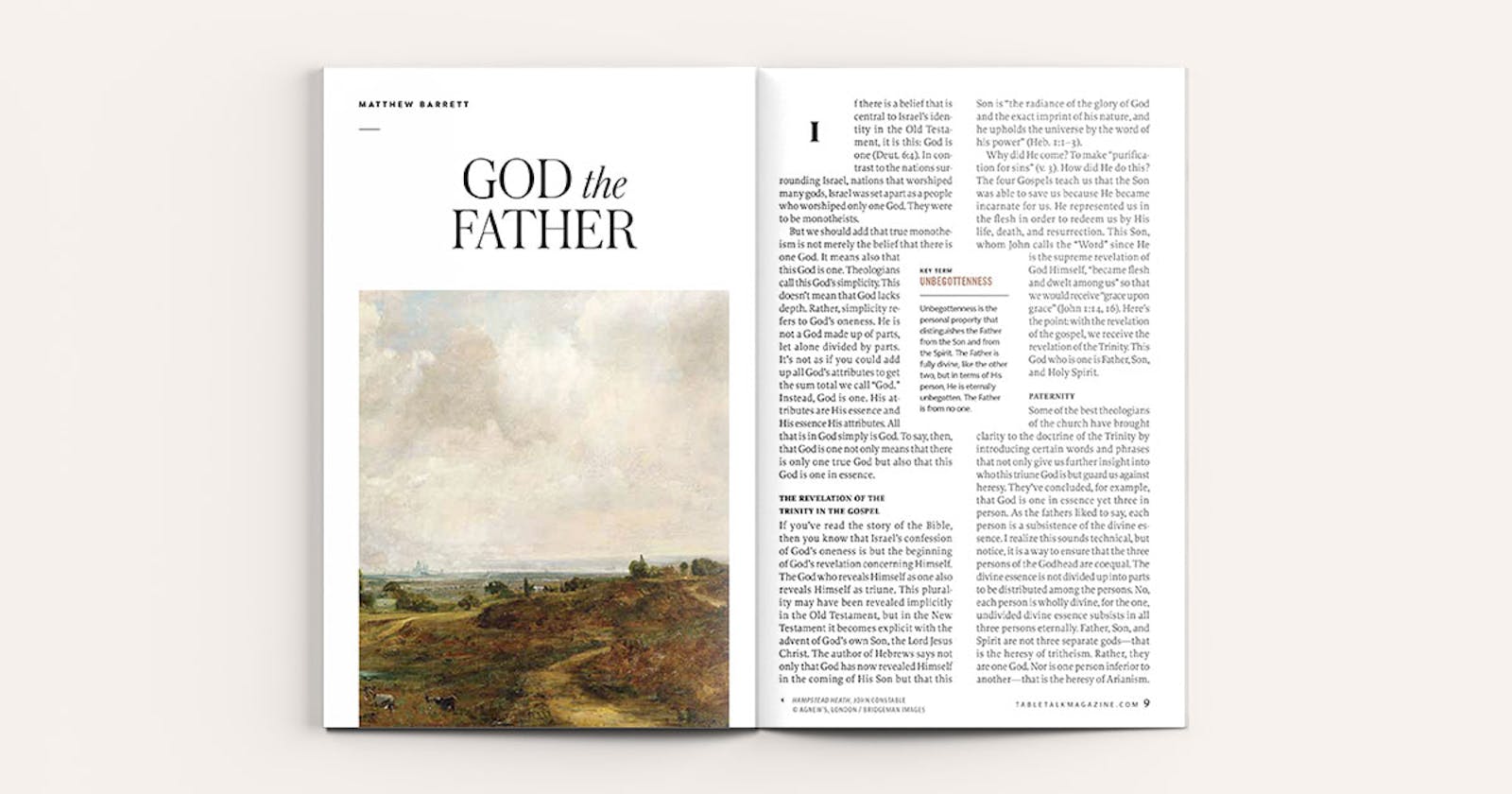
Request your free, three-month trial to Tabletalk magazine. You’ll receive the print issue monthly and gain immediate digital access to decades of archives. This trial is risk-free. No credit card required.
Try Tabletalk NowAlready receive Tabletalk magazine every month?
Verify your email address to gain unlimited access.
If there is a belief that is central to Israel’s identity in the Old Testament, it is this: God is one (Deut. 6:4). In contrast to the nations surrounding Israel, nations that worshiped many gods, Israel was set apart as a people who worshiped only one God. They were to be monotheists.
But we should add that true monotheism is not merely the belief that there is one God. It means also that this God is one. Theologians call this God’s simplicity. This doesn’t mean that God lacks depth. Rather, simplicity refers to God’s oneness. He is not a God made up of parts, let alone divided by parts. It’s not as if you could add up all God’s attributes to get the sum total we call “God.” Instead, God is one. His attributes are His essence1 and His essence His attributes. All that is in God simply is God. To say, then, that God is one not only means that there is only one true God but also that this God is one in essence.
the revelation of the trinity in the gospel
If you’ve read the story of the Bible, then you know that Israel’s confession of God’s oneness is but the beginning of God’s revelation concerning Himself. The God who reveals Himself as one also reveals Himself as triune. This plurality may have been revealed implicitly in the Old Testament, but in the New Testament it becomes explicit with the advent of God’s own Son, the Lord Jesus Christ. The author of Hebrews says not only that God has now revealed Himself in the coming of His Son but that this Son is “the radiance of the glory of God and the exact imprint of his nature, and he upholds the universe by the word of his power” (Heb. 1:1–3).
Why did He come? To make “purification for sins” (v. 3). How did He do this? The four Gospels teach us that the Son was able to save us because He became incarnate for us. He represented us in the flesh in order to redeem us by His life, death, and resurrection. This Son, whom John calls the “Word” since He is the supreme revelation of God Himself, “became flesh and dwelt among us” so that we would receive “grace upon grace” (John 1:14, 16). Here’s the point: with the revelation of the gospel, we receive the revelation of the Trinity. This God who is one is Father, Son, and Holy Spirit.
paternity
Some of the best theologians of the church have brought clarity to the doctrine of the Trinity by introducing certain words and phrases that not only give us further insight into who this triune God is but guard us against heresy. They’ve concluded, for example, that God is one in essence yet three in person. As the fathers liked to say, each person is a subsistence of the divine essence. I realize this sounds technical, but notice, it is a way to ensure that the three persons of the Godhead are coequal. The divine essence is not divided up into parts to be distributed among the persons. No, each person is wholly divine, for the one, undivided divine essence subsists in all three persons eternally. Father, Son, and Spirit are not three separate gods—that is the heresy of tritheism. Rather, they are one God. Nor is one person inferior to another—that is the heresy of Arianism. Rather, they are coeternal and coequal, being one God.
In our attempt to avoid tritheism we dare not fall into the trap of modalism, the belief that there is one God who merely changes into three different forms. This, too, is a heresy, for it denies that Father, Son, and Spirit are actual persons, distinct from one another. Instead, it teaches that they are mere masks worn by the one person we call God.
But what exactly distinguishes the three persons? Well, think about what names Scripture has used to reveal these three persons to us: Father, Son, and Spirit. The first person is the Father because He is the Father of the Son. But unlike our human conception of fatherhood, God the Father is a Father to His Son eternally. Also, unlike human fathers, God the Father has no Father Himself. Never has He been a Son. His paternity is eternal and without origin.
The second person is the Son because He is generated or begotten by His Father. But unlike human generation, there never was a time when the Son was not. His generation is an eternal generation, His begottenness an eternal begottenness. The third person is called Spirit because He is spirated by the Father and the Son (or proceeds from the Father and the Son). He is not a second Son, as if He were a brother to the Son, nor is He a grandson of the Father. He is the Spirit because He is not generated or begotten but spirated.
In theology, what we are describing are called “eternal relations of origin,” and they alone distinguish the three persons and identify their personal properties (unbegottenness,2 filiation or begottenness, spiration or procession).
the principle
Maybe you noticed this already, but these eternal relations of origin are unique to each person of the Trinity. They are incommunicable, meaning they are not interchangeable. Consider the Father, for example. He alone is unbegotten and without generation and spiration. That cannot be said of the Son, who is eternally begotten by the Father, nor of the Spirit, who is eternally spirated by the Father and the Son. The Father alone is unbegotten; this is His unique personal property. For that reason, the church fathers liked to call the Father the “principle” (or “source” or “origin”) in the Godhead. In fact, He is the principle without principle, for He alone proceeds from no one and is generated or begotten by no one. This is what paternity means in the Trinity, and it explains why God reveals His triune identity the way He does.

For instance, have you ever wondered why Jesus, in John’s gospel, makes such a big deal of the fact that He is sent as the Son by the Father (e.g., John 5:24, 30, 36)? Why is it not the other way around, the Father being sent by the Son instead? While some say it is arbitrary, we beg to differ. The reason the Son is sent by the Father is because the Son is from the Father eternally, because He is eternally generated or begotten by the Father.
The point is that the missions of the Trinity in salvation history (the sending of the Son in the incarnation and the outpouring of the Spirit at Pentecost) intentionally reflect the relations of the three persons in eternity. And what reflects the Father as principle and source more than when He sends His Son in history, the very Son whom He has begotten from all eternity such that there never was a time when the Son was not? In that light, Scripture often orders or names the Father first (Matt. 28:19; 1 John 5:7), not because the Son and Spirit are less than the Father in nature or come after the Father in time—all three are coeternal and coequal, as the Athanasian Creed says. Rather, it is because the Father, as unbegotten, is the source and principle from whom the Son is begotten and from whom the Spirit is spirated. That order is reflected in history when the Son and then the Spirit are sent by the Father, their source and origin.
the architect
If the Father is the principle of the Trinity due to His paternity, it is also appropriate to title Him the architect of creation and salvation. On the one hand, every external act of the Trinity toward the created order is the single, undivided act of the whole Trinity. The external works of the Trinity are undivided, meaning that the three persons act as one in salvation because they are one in nature and will.
At the same time, particular works may terminate on distinct persons of the Godhead—this is called “divine appropriations.” Consider the incarnation, for example. It is not accomplished by the Son alone but is the trophy of the entire Godhead. And yet, it is the person of the Son who takes on flesh. Something similar can be said of the Spirit at Pentecost.
But what about the Father? While creation and salvation are works of all three persons, we are right to speak of the Father as architect. The Father creates the world through His Word (the Son) by His Spirit. Similarly, the Father redeems His elect through His Son by His Spirit.
More broadly, while redemption is planned, accomplished, and applied by the entire Trinity, specific aspects of this saving work can be appropriated to distinct persons according to their unique personal properties. As principle, origin, and source, the Father sends His Son to become incarnate to accomplish redemption, only to then (with the Son) send His Holy Spirit to apply redemption to God’s elect. The Father is architect of our salvation, the Son the executor of that salvific plan, and the Spirit its perfecter. As the Reformed theologian Johannes Van der Kemp said so poetically, “The Father ordained grace for the elect, the Son purchased it, and the Holy Ghost applies and dispenses it to the favorites of God.”
children of the father
If God the Father is the architect of our salvation, then we have great assurance that we are His adopted sons. Our sonship is different from the Sonship of the second person of the Trinity (ours by grace, His by nature). Yet, it is because the Father is the principle and architect of our salvation, the One who sent His only begotten Son, that we can be adopted into His family in and through Christ and invited to call Him our Father.
- God’s essence, or ousia, is the one divine nature or substance, that which makes Him God. Father, Son, and Holy Spirit are homoousios, “of the same essence”—each person is fully and equally God, and They are one God. Each person is identical in terms of the divine attributes—equal in being, wisdom, power, holiness, justice, goodness, truth, authority, and every other aspect of deity. ↩︎
- Unbegottenness is the personal property that distinguishes the Father from the Son and from the Spirit. The Father is fully divine, like the other two, but in terms of His person, He is eternally unbegotten. The Father is from no one. ↩︎
